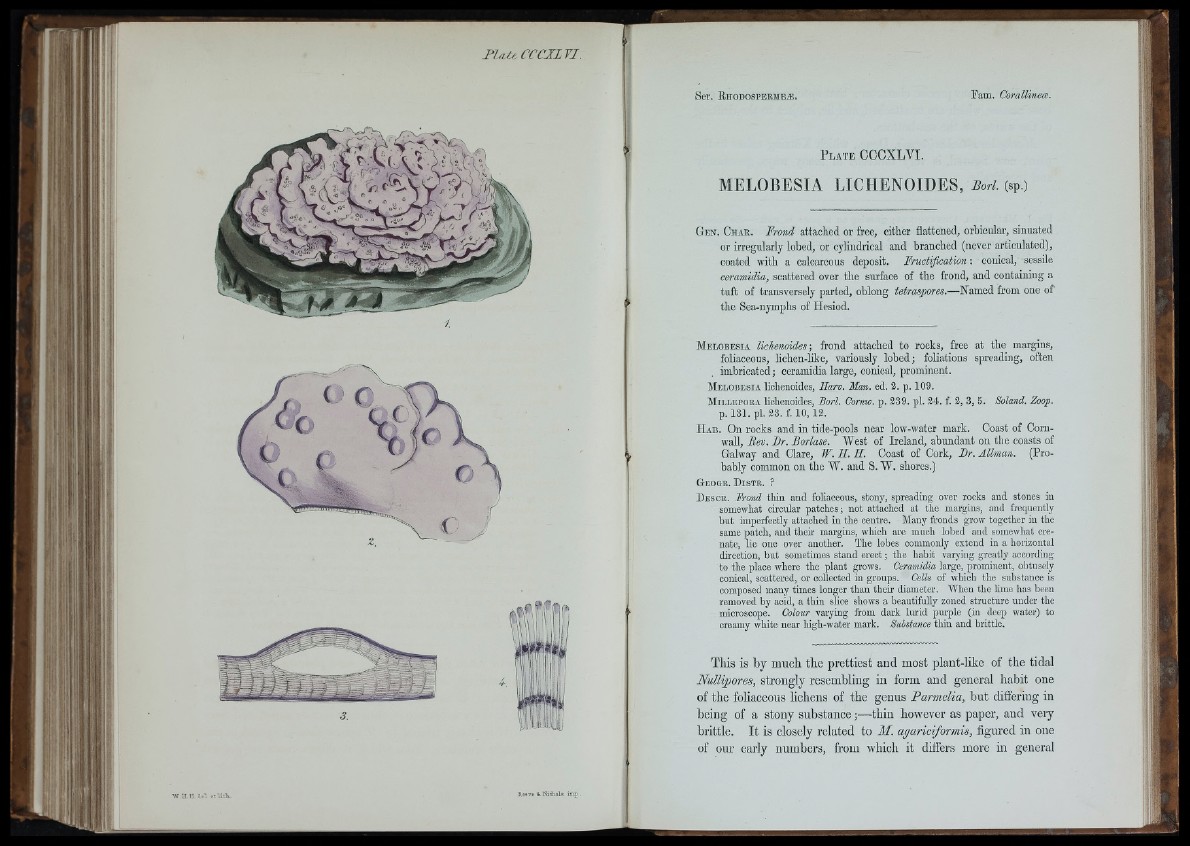
! î:.
I
P l a t e CCCXLVI.
MELOBESIA LICHENOIDES, Bori (sp.)
G e n . Ch a e . Frond attached or free, either flattened, orbicular, sinuated
or irregularly lobed, or cyliudrioal and branched (never articulated),
coated with a calcareous deposit. Fructijication: conical, sessile
ceramidia, scattered over the surface of the frond, and containing a
tuft of transversely parted, oblong tetraspores.—Named from one of
the Sea-nymphs of Hesiod.
M e lo b e s i a lichenoides; frond attached to rooks, free at the margins,
foliaceous, lichen-like, variously lobed; foliations spreading, often
imbricated; ceramidia large, conical, prominent.
Melobesia lichenoides, Harv. Man. ed. 3. p. 109.
Millepoea lichenoides, Borl. Cornw. p. 339. pi. 34. f. 3, 3, 5. Soland. Zoop.
p . 1 31.pl. 33. f. 10, 13.
H a b . On rocks and in tide-pools near low-water mark. Coast of Cornwall,
Rev. B r. Borlase. West of Ireland, abundant on the coasts of
Galway and Clare, W. H . H . Coast of Cork, B r . Allman. (Probably
common on tbe W. and S. W . shores.)
Geoge. D is t e . ?
D e sc e . Frond thin and foliaceous, stony, spreading over rocks and stones in
somewhat circular patches; not attached at the margins, and frequently
but imperfectly attached in the centre. Many fronds grow together in the
same patch, and then- margins, which are much lobed and somewhat crenate,
lie one over another. The lobes commonly extend in a horizontal
direction, but sometimes stand erect; the habit varying greatly according
to the place where the plant grows. Ceramidia large, prominent, obtusely
conical, scattered, or collected in groups. Cells of which the substance is
composed many times longer than their diameter. When the lime has been
removed by acid, a thin slice shows a beautifully zoned structure under the
microscope. Colour varying from dark lurid purple (in deep water) to
creamy white near high-water mark. Substance thin and brittle.
Tills is by mucb tbe prettiest and most plant-like of the tidal
Nullipores, strongly resembling in form and general babit one
of the foliaceous lichens of tbe genus Parmelia, but differing in
being of a stony substance ;—thin however as paper, and very
brittle. It is closely related to M. agariciformis, figured in one
of our early numbers, from which it differs more in general
I
Ii
f
ill
ii ■I f ■;
. i l
Mb.